Archery equipment for scout activities is a crucial aspect of ensuring a safe and enjoyable experience for young archers. This guide delves into the various types of equipment, selection criteria, range setup, teaching methods, and maintenance practices to empower scout leaders and parents with the knowledge they need to facilitate successful archery programs.
From selecting the appropriate bows and arrows to establishing safety protocols and teaching effective techniques, this comprehensive resource provides a roadmap for creating a thriving archery environment for scouts.
Types of Archery Equipment

Archery is a popular and challenging activity that can be enjoyed by people of all ages. Scouts can learn about archery safety, technique, and equipment through organized programs and activities.
There are many different types of archery equipment available, and the type of equipment that is best for a scout will depend on their age, size, and skill level.
Types of Bows
The three main types of bows used in archery are recurve bows, compound bows, and traditional bows.
- Recurve bowsare the most common type of bow used by scouts. They are relatively simple to learn to shoot, and they can be used for target shooting, hunting, and 3D archery.
- Compound bowsare more powerful than recurve bows, and they are often used by experienced archers. Compound bows have a system of pulleys and cables that helps to reduce the draw weight, making them easier to shoot.
- Traditional bowsare the oldest type of bow, and they are still used by many archers today. Traditional bows do not have any pulleys or cables, and they require more strength to shoot than recurve or compound bows.
Arrow Types, Archery equipment for scout activities
Arrows are another important piece of archery equipment. Arrows come in a variety of materials, sizes, and fletching options.
- Materials:Arrows can be made from a variety of materials, including wood, aluminum, carbon fiber, and fiberglass. Wood arrows are the most traditional type of arrow, but they are not as durable as aluminum or carbon fiber arrows.
- Sizes:Arrows come in a variety of sizes, which are determined by the length of the arrow shaft. The length of the arrow shaft will depend on the archer’s draw length.
- Fletching:Arrows have fletching, which are feathers or plastic vanes that help to stabilize the arrow in flight. Fletching can be made from a variety of materials, including turkey feathers, goose feathers, and plastic.
Safety Gear
Safety gear is essential for archery. Archers should always wear arm guards, finger tabs, and chest protectors when shooting.
- Arm guardsprotect the archer’s forearm from the bowstring.
- Finger tabsprotect the archer’s fingers from the bowstring.
- Chest protectorsprotect the archer’s chest from the bowstring.
Selecting Equipment for Scout Activities: Archery Equipment For Scout Activities
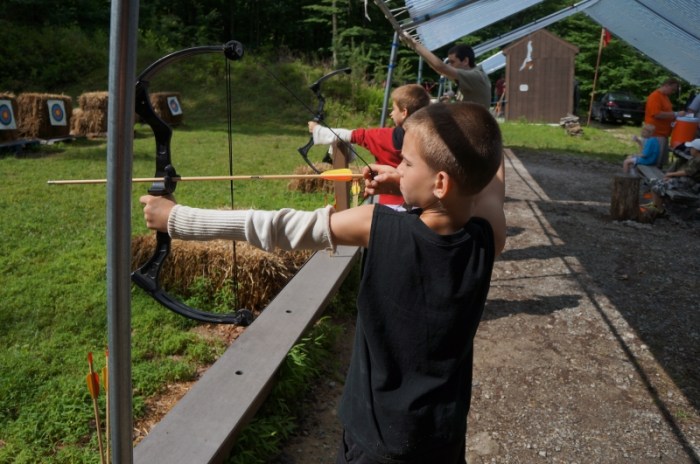
When selecting archery equipment for scout activities, it is essential to consider the age, strength, and skill level of the participants. This ensures that they have equipment that is appropriate for their abilities and helps them develop their archery skills safely and effectively.
Bows
The choice of bow depends on the archer’s age, strength, and skill level. For younger or less experienced scouts, a lighter bow with a lower draw weight is recommended. As they gain strength and experience, they can gradually transition to bows with higher draw weights.
Arrows
The weight and length of arrows should be appropriate for the bow being used. Heavier arrows are more stable in flight but require more strength to shoot, while lighter arrows are faster but less stable. The length of the arrow should be long enough to reach the target but not so long that it becomes difficult to control.
Safety Gear
Safety gear is essential for archery activities. This includes arm guards, finger tabs, and eye protection. These items help protect the archer from injuries caused by the bowstring or arrows.
- Arm guardsprotect the archer’s forearm from the bowstring.
- Finger tabsprotect the archer’s fingers from the bowstring.
- Eye protectionshields the archer’s eyes from arrows or other projectiles.
When choosing safety gear, it is important to consider fit and comfort. The gear should fit snugly without being too tight or loose, and it should be comfortable to wear for extended periods.
Archery Range Setup and Safety Procedures
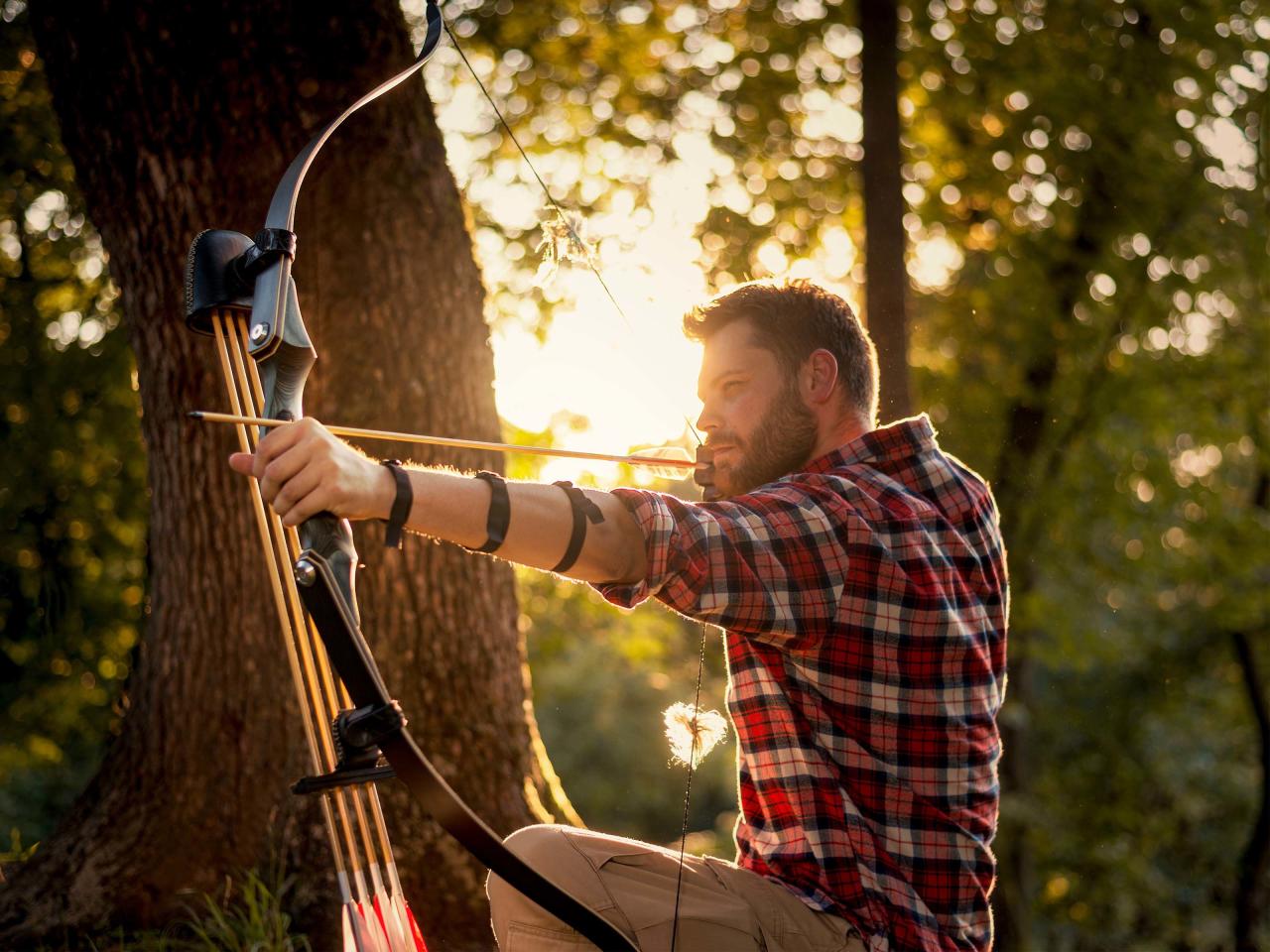
Ensuring a safe and organized archery range is paramount for scout activities. A well-designed layout and clear safety protocols minimize risks and enhance the overall experience.
Range Layout
The archery range should be designed to provide ample space for archers, targets, and retrieval zones. A typical layout includes:
- Shooting Line:A designated line where archers stand to shoot arrows.
- Target Area:A section where targets are placed at varying distances from the shooting line.
- Retrieval Zone:An area behind the targets where arrows are retrieved.
- Safety Zones:Designated areas on either side of the range where non-participants can observe safely.
Safety Rules and Protocols
Clear safety rules and protocols are essential to prevent accidents and injuries:
- Target Placement:Targets must be securely anchored and placed at appropriate distances for the archers’ skill level.
- Shooting Distances:Archers should shoot at distances commensurate with their abilities, ensuring arrows do not overshoot or undershoot the target.
- Arrow Handling:Arrows must be handled with care, pointing down or away from others at all times.
- Arrow Retrieval:Only designated individuals should retrieve arrows, ensuring they are collected safely without crossing the shooting line.
- Storage:Arrows and other equipment should be stored securely when not in use to prevent tripping hazards or accidental damage.
Teaching Archery to Scouts
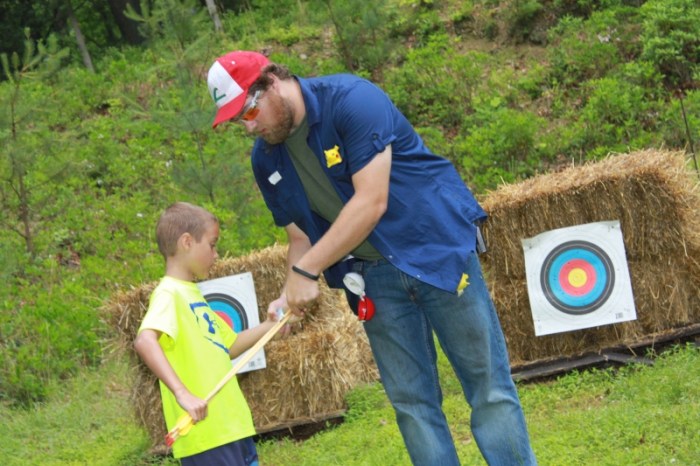
Introducing archery to scouts requires a structured approach that emphasizes safety, technique, and skill development. This involves creating a comprehensive lesson plan that Artikels the basics of archery, establishing a progression of exercises, and implementing strategies to engage and motivate scouts.
Lesson Plan for Introducing Archery
- Safety First:Cover essential safety rules, including handling bows and arrows, range etiquette, and emergency procedures.
- Basic Technique:Demonstrate the proper stance, grip, aiming, and release. Provide hands-on practice to reinforce these techniques.
- Target Practice:Start with close-range targets and gradually increase the distance as scouts improve their accuracy.
- Distance Shooting:Challenge scouts to shoot at varying distances to develop their range estimation skills.
- Archery Games:Incorporate fun and engaging games, such as target competitions or archery tag, to keep scouts motivated.
Progression of Exercises
To foster skill development, establish a progression of exercises that gradually increase in difficulty and complexity:
- Stationary Targets:Start with stationary targets to allow scouts to focus on technique and accuracy.
- Moving Targets:Introduce moving targets to challenge scouts’ reaction time and tracking abilities.
- Distance Shooting:Gradually increase the distance between the archer and the target to develop range estimation and windage compensation.
- Trick Shots:Introduce advanced shots, such as split shots or Robin Hood shots, to enhance skill and precision.
Motivating and Engaging Scouts
Maintaining scout engagement is crucial for their archery journey. Implement the following strategies:
- Set Realistic Goals:Establish achievable goals to build confidence and avoid frustration.
- Positive Reinforcement:Recognize and praise scouts’ progress, no matter how small.
- Competition and Camaraderie:Foster a friendly competitive spirit while emphasizing teamwork and support.
- Variety and Fun:Incorporate a variety of activities, such as archery games or simulations, to keep scouts engaged.
- Scout-Led Activities:Empower scouts by allowing them to plan and lead archery activities, fostering ownership and responsibility.
Maintenance and Repair of Archery Equipment
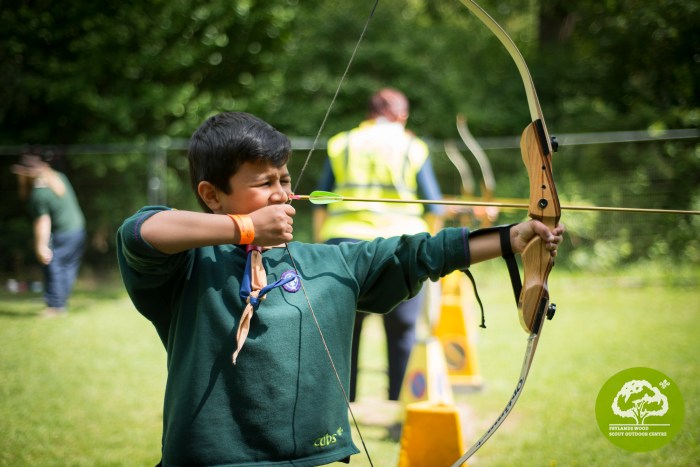
Proper maintenance and repair of archery equipment are crucial for ensuring safety and optimal performance. Establishing a regular maintenance schedule and knowing how to inspect and repair minor damage can extend the lifespan of equipment and prevent accidents.
Maintenance Schedule
*
-*Bows
Inspect bowstrings for fraying or damage every time before use. Check bow limbs for cracks or splinters regularly.
-
-*Arrows
Inspect arrow shafts for cracks, dents, or warping. Check arrowheads for sharpness and secure fit.
-*Safety Gear
Examine armguards, finger tabs, and chest protectors for tears or punctures. Ensure they fit snugly and provide adequate protection.
Inspection and Repair
*
-*Bowstrings
Replace frayed or damaged bowstrings immediately.
-
-*Bow Limbs
Minor cracks can be repaired with specialized epoxy or by a professional bowyer.
-*Arrow Shafts
Small cracks can be repaired with cyanoacrylate glue. Warped shafts should be discarded.
-*Arrowheads
Sharpen dull arrowheads using a file or sharpening stone. Loose arrowheads should be reattached securely.
-*Safety Gear
Repair tears or punctures in safety gear with patches or sewing. Replace severely damaged gear.
Proper Storage and Transportation
*
-*Bows
Store bows unstrung in a dry, temperature-controlled environment. Avoid exposing them to extreme heat or cold.
-
-*Arrows
Store arrows in a quiver or tube to protect them from damage.
-*Safety Gear
Keep safety gear in a designated storage area to prevent damage or loss.
-*Transportation
When transporting archery equipment, secure it properly to prevent damage or injury during transit.
By adhering to a regular maintenance schedule, inspecting equipment regularly, and storing and transporting it properly, scout troops can ensure the longevity and safety of their archery equipment for years to come.
Final Review
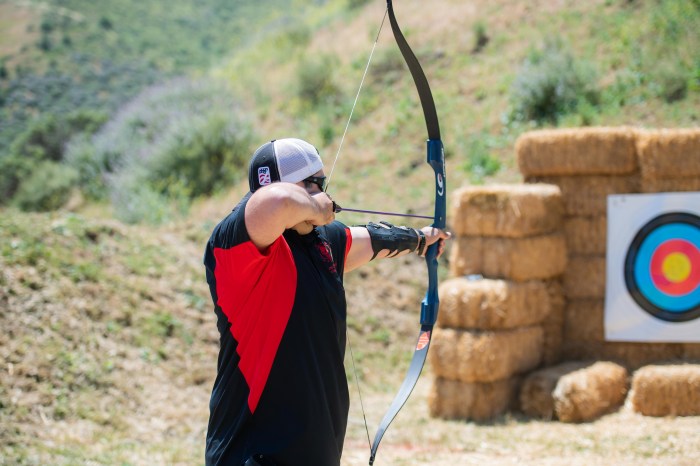
By following the guidelines Artikeld in this guide, scout leaders can foster a passion for archery among their scouts, while prioritizing safety and fostering a lifelong appreciation for this timeless sport.
FAQ Explained
What are the different types of bows suitable for scout activities?
Recurve, compound, and traditional bows are commonly used for scout activities, each with its unique characteristics and suitability for different age groups and skill levels.
How do I select the appropriate arrows for my scouts?
Arrow selection should consider factors such as the archer’s age, strength, and skill level, as well as the intended shooting distance and target type.
What safety gear is essential for archery activities?
Arm guards, finger tabs, and chest protectors are crucial safety gear that protect archers from potential injuries during shooting and arrow retrieval.
How do I set up a safe and efficient archery range for scouts?
Range setup involves designating target placement, establishing shooting distances, and implementing clear safety rules and protocols to minimize risks.
What are some effective methods for teaching archery to scouts?
Introducing basic techniques, providing a progression of exercises, and fostering motivation through games and challenges can help scouts develop their archery skills and confidence.
